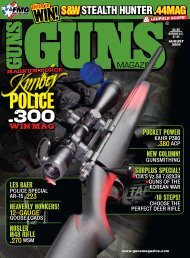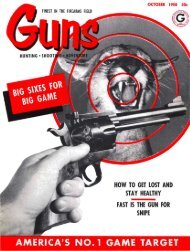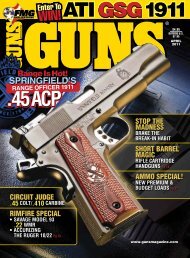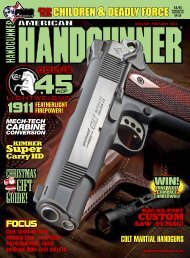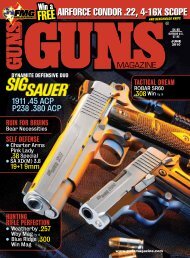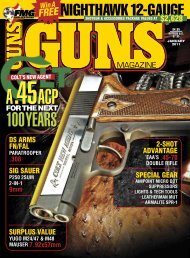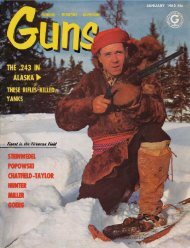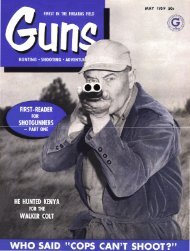Guns 2012-08.pdf - Jeffersonian
Guns 2012-08.pdf - Jeffersonian
Guns 2012-08.pdf - Jeffersonian
You also want an ePaper? Increase the reach of your titles
YUMPU automatically turns print PDFs into web optimized ePapers that Google loves.
STORY: Jacob Gottfredson<br />
Elite Tactical<br />
Riflescope<br />
Bushnell’s new DMR 3.5-21x50mm.<br />
Bushnell has entered the tactical market, and the<br />
result is surprisingly good. From the massive bubblewrapped<br />
genre to the rigors of an upscale tactical<br />
riflescope, is this a leap of faith or a change in the<br />
manufacturer’s direction?<br />
I reported some months ago on<br />
Bushnell’s new Legend Ultra HD<br />
binocular. It is a fine piece of glass and<br />
goes well with my favorite carry laser<br />
rangefinder, which Bushnell also calls<br />
the Legend.<br />
They then proceeded to blow the lid<br />
off that combo by offering the Bushnell<br />
Fusion 1600 ARC! No more having to<br />
carry two instruments. And I found<br />
the Fusion to work exceedingly well,<br />
in many cases to a mile. The bino also<br />
tells the rifleman his comeups to the<br />
target. I used it during a recent hunt<br />
in the Rocky Mountains and was not<br />
disappointed.<br />
Now they have entered the tactical<br />
market as well. The last few tactical<br />
matches over the past year and a half<br />
have seen more and more of their<br />
new glass atop expensive, competitive<br />
tactical rifles.<br />
Having seen them at matches, I was<br />
excited to get one in my hands to do a<br />
test and review. However, the exercise,<br />
over a period of year, was unsuccessful<br />
in getting exactly what I wanted. To wit:<br />
they have several innovative reticles for<br />
holdover as well as wind and moving<br />
target holds. What I finally received was<br />
a Mil-Dot scope of the Army variety,<br />
i.e., big round balls in the front focal<br />
plane.<br />
I am a rear focal plane guy, which is<br />
strictly a personal preference. There are<br />
advantages and disadvantages to each.<br />
In a front focal plane, the reticle<br />
has little chance of changing point of<br />
impact through power changes, and you<br />
can still range and use the hashmarks at<br />
any power. But the reticle becomes very<br />
small at low powers and sometimes too<br />
big at high powers. The rear focal plane<br />
reticle does not have the latter problem,<br />
but you can become confused and miss<br />
a target because the hashmarks change<br />
with different power settings.<br />
I remember a befuddling range<br />
session with a 7mm Remington<br />
Magnum. I would pick a hashmark<br />
and miss a shot at a known distance.<br />
The rifle had always performed<br />
perfectly. I finally decided something<br />
was wrong with the scope and started<br />
driving home, trying to sort out in my<br />
mind what could have gone wrong.<br />
Suddenly it dawn on me. I stopped<br />
and looked at the power setting. Just<br />
as I thought, the power setting was not<br />
on max. I returned to the range, put<br />
the power on max, and all was once<br />
again well. That would not happen<br />
with a front focal plane reticle. Still, I<br />
can vary the hashmark subtension by<br />
simply changing the power on a rear<br />
focal plane reticle. If the standard is 2<br />
MOA per hashmark on max power, it<br />
is 4 MOA at half power, which presents<br />
great flexibility.<br />
The new Bushnell Elite<br />
3.5-21x50mm Tactical scopes set<br />
up on LaRue rifles for field trials.<br />
8<br />
WWW.GUNSMAGAZINE.COM • AUGUST <strong>2012</strong>




